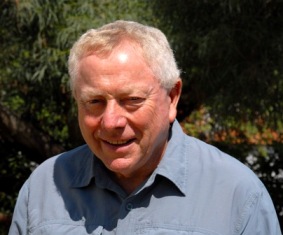Out with Papa-figos

Clive Viney - co-author of Algarve Wildlife - the natural year
Papa-figos (which literally translates as fig eater) is the Portuguese name for the Golden Oriole, one of the iconic visiting birds of the Algarve. Clive Viney is the co-author of Algarve Wildlife - the natural year, and now, under the guise of Papa-Figos, chronicles his finds, thoughts and feelings while walking in the Algarve countryside throughout the natural year. Look out for his regular updates, illustrated by his fellow co-author and photographer, Ray Tipper, who has kindly provided some of the photographs that illustrate these articles by clicking through from the links below.
Global Big Day - 22nd May 2020

The Roman Bridge at Tavira - Picture Ray Tipper: Licence enquiry...
Compared to many European countries Portugal has managed to cope with Covid-19 reasonably well. The border with Spain was swiftly closed and Faro Airport was all but shut. I can’t remember when I last heard an aeroplane or saw a vapour trail. Movement of people within Portugal was restricted, especially for those living in conurbations such as Lisbon and Porto. The Algarve has faired especially well and in my municipality of Tavira, just 30 kilometres from the Spanish border, there have been no deaths and relatively few cases of infection; in fact no cases for the past couple of weeks. Portugal has been in a state of emergency but at the beginning of May this was not renewed, although restrictions remain in force. For example, social distancing has to be maintained and shopping malls and cinermas remain closed. On the other hand, restaurants, hairdressers, small shops, garages and garden centres are open and playing golf is permissible but changing rooms must remain closed.

Iberian Azure-winged Magpie - Picture Ray Tipper: Licence enquiry...
With a partial lockdown in force, I thought that it would be a good idea to list for eBird’s Global Big Day birds that could be recorded locally. My target was the typical golf par of 72. The morning would be spent on my local patch, where I live overlooking Tavira with a pre-dawn start to try and add Red-necked Nightjar. After lunch at home I would do a circuit of the Ria Formosa Reserve to the east of Tavira. Then for diversity I intended to check out freshwater habitats a few kilometres away.

Crown Daisies
The morning went quite well but my nightjar was distant to say the least and at first light I found myself at Pego do Inferno in the Assêca Valley, which was very birdy and I had it to myself. This is an area of traditional farmland and citrus orchards where several Nightingales and a rich dawn chorus serenaded me. At a nearby woodland I saw a summering Robin and Wrens, Cetti’s Warblers and Blackcaps were in full voice. In the eastern Algarve Robins are common winter visitors but most head to the hills and further north in April. A superb male Golden Oriole posed just for me and Iberian Azure-winged Magpies added more colour. An ambling Red Fox was a bonus, as was a splendid patch of Bee Orchids. The first three months of the year were bone dry, which did not encourage orchids and other wildflowers but April and May have fortunately been very wet. On a lovely trail into the hills I photographed a colourful Western Clubtail dragonfly, which was the first that I’d seen near home. A pair of Woodchat shrikes was enjoyed and the female carrying food indicated successful breeding. In a hayfield full of Crown Daisies a Common Quail quipped. A fierce-looking Little Owl on an overhead wire and then on the ground took a great interest in me. Late in the morning, I walked up the parallel Almargem Valley through more farmland, where a singing Melodious Warbler was the best of the birds. I was then ready for a slow lunch and a rest at home.

Bee Orchids
At two o’clock, full of expectancy, I set out for the saltpans and saltmarsh of the nearby Ria Formosa. This is a hugely birdy area, full of shorebirds, gulls and terns but as soon as I arrived it began to rain steadily. I drove to the deserted beach on the Tavira Channel, which could be viewed in the now pouring rain from the comfort of the Discovery but there was precious little to observe. The best were a Caspian Tern, plunge-diving Little Terns and two Audouin’s Gulls flying past. The rain wasn’t easing up, so I thought a circuit of the saltpans in the Discovery would be the best way to see birds. I had travelled about a 100 metres along an unmade track by an impoundment when the Discovery began sliding dangerously all over the place, with deep drops either side. I decided to reverse back to the compacted road and to say the least, as I skidded from side to side with my brakes useless, it was hair-raising. After that it was still raining and my nerves were shattered, so I called it a day. My tally was a modest 56 species but it was great to be out and about and as soon as I had changed and put my feet up with a cup of coffee the sun came out. So typically Algarvian but right now there is nowhere in the world that I’d rather be.


